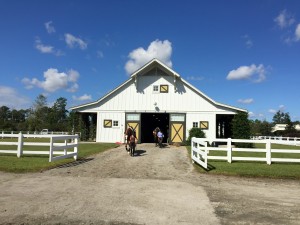The Necessity of Good Ventilation in a Horse Barn
The goal of ventilation is to provide fresh air to the horses in your barn. Proper ventilation must allow two things; air exchange and air distribution. The air exchange allows for fresh air to enter the barn while stale air also has the ability to escape. Fresh air must be able to reach all the stalls within the barn as well. It is much more natural for horses to be in a slightly colder but airy barn, compared to a cooped-up, airtight facility. Lacking proper ventilation will lead to a variety of preventable equine health issues. In addition, ventilation is a year-round requirement. It is not something that is necessary only in the summer or winter.
A stabled horse requires 1,600 square feet of air. Providing proper ventilation to the stabled horse can present challenges depending on the season of year. While ventilation challenges exist year-round, the challenges listed below seem to be more difficult to address during these specific seasons.
Summer:
• Removing heat.
Proper ventilation allows the stale, hot air to exit the barn while bringing in cooler, fresh air. This is crucial during hot temperatures when your horses are already at risk for overheating.
• Removing moisture.
By breathing, the average horse gives off about 2 gallons of moisture daily. In the winter when barns are typically closed, removing moisture is a necessity. High moisture levels are can harmful to your horses. Excess moisture allows fungus and bacteria to easily flourish. Additionally, moisture can aggravate arthritis.
Dust must be removed to prevent respiratory issues like heaves. Dust is a larger issue in barns that have their stalls circulated around an indoor arena.
Ammonia is infamous for having excessively negative impacts. Ammonia must be driven out of barns since it can harm a horse’s eyes and respiratory system.
Through removing odors and airborne pathogens, you can create a healthier living environment for your horse. In addition, it also creates a better working condition for yourself and your employees.
Harris, Susan E., and The United States Pony Club, Inc. The United States Pony Clubs Manual of Horsemanship: Advanced Horsemanship HB-A Levels. 2nd ed. Danvers: John Wiley & Sons, 2014. Print.
-
Articles
- November 2024
- October 2024
- September 2024
- August 2024
- July 2024
- June 2024
- May 2024
- April 2024
- March 2024
- February 2024
- January 2024
- December 2023
- November 2023
- October 2023
- September 2023
- August 2023
- July 2023
- June 2023
- May 2023
- April 2023
- March 2023
- February 2023
- December 2022
- November 2022
- October 2022
- September 2022
- August 2022
- July 2022
- June 2022
- May 2022
- April 2022
- March 2022
- February 2022
- January 2022
- December 2021
- November 2021
- October 2021
- September 2021
- August 2021
- July 2021
- May 2021
- April 2021
- March 2021
- February 2021
- January 2021
- December 2020
- November 2020
- October 2020
- September 2020
- August 2020
- July 2020
- June 2020
- May 2020
- April 2020
- March 2020
- February 2020
- January 2020
- December 2019
- November 2019
- October 2019
- September 2019
- August 2019
- July 2019
- June 2019
- May 2019
- April 2019
- March 2019
- February 2019
- January 2019
- December 2018
- November 2018
- October 2018
- September 2018
- August 2018
- July 2018
- June 2018
- May 2018
- April 2018
- March 2018
- February 2018
- January 2018
- November 2017
- October 2017
- September 2017
- August 2017
- July 2017
- June 2017
- May 2017
- April 2017
- March 2017
- February 2017
- January 2017
- December 2016
- October 2016
- September 2016
- August 2016
- July 2016
- June 2016
- May 2016
- April 2016
- March 2016
- February 2016
- January 2016
- December 2015
- November 2015
- October 2015
- August 2015
- June 2015
- May 2015
- March 2015
- November 2014
- March 2014
- October 2013
- September 2013
- August 2013
- January 2013
- December 2012
- November 2012
- October 2012
- September 2012
- January 2012
- October 2011
- September 2011
- August 2011
- July 2011
- June 2011
- February 2011
-
Meta





